#hominin fossils
Explore tagged Tumblr posts
Text

Genetic Time Capsules: Uncovering Neanderthal and Denisovan Influences
The discovery of ancient hominin fossils such as Lucy and the Neanderthal has undoubtedly revolutionized our understanding of human evolution. These remarkable finds have not only challenged traditional theories but have also opened up new avenues for research, particularly in the field of paleoanthropology and the analysis of ancient DNA.
The excavation of Lucy, a 3.2 million year old hominin skeleton, was a turning point in paleoanthropology. Lucy provided crucial evidence for humanity's African origins and the early development of bipedalism, but it is important to acknowledge that the interpretation of Lucy's anatomy and its implications are the subject of ongoing debate among paleoanthropologists. While her skeleton shows a mix of ape- and human-like features, the degree to which she represents a transitional form and the exact nature of her locomotion remain areas of scientific investigation. The Institute of Human Origins (IHO) has played a significant role in advancing our understanding of human origins through its multidisciplinary approach. By bringing together experts from different fields, the IHO has contributed to a more holistic understanding of human evolution. This approach is particularly evident in their involvement in ancient DNA research, which has provided unprecedented insights into the genetic history of our species.
The pioneering work of Dr. Svante Pääbo, despite initial difficulties, paved the way for the successful sequencing of the Neanderthal genome. This achievement provided direct evidence of interbreeding between Neanderthals and modern humans and challenged long-held assumptions about the nature of their relationship. The impact of the Neanderthal Genome Project is revealing the genetic legacy of Neanderthals in present-day non-African populations and the extent and significance of this genetic contribution is still being investigated. Recent studies suggest that Neanderthal DNA may have been subject to selection in modern humans, with some regions showing signs of positive selection while others have been lost over time. This complexity adds another layer to our understanding of genetic interactions between ancient and modern humans.
The discovery of Denisovans, an ancient human species identified through DNA analysis, further complicates the story of human evolution. Denisovan DNA is found in modern populations of East Asia, Oceania, and Southeast Asia, with the highest concentrations in Aboriginal Australians and Papuans. The geographic distribution and population history of Denisovans are still not fully understood. Recent research suggests that Denisovans may have been more diverse and widespread, and may have interacted and interbred with other hominin groups. Studying the genomes of Neanderthals and Denisovans has provided valuable insights into physiological and health-related traits. While the discussion of genetic variants related to pain sensitivity and immune responses is intriguing, the functional implications of these variants are still being explored, and the complex interplay between genetic variants and their impact on modern human traits and diseases requires further investigation.
The Neanderthal genetic legacy in modern humans addresses the fascinating topic of inherited genetic variants and their potential impact on various traits and diseases. The example of the Neanderthal variant associated with premature birth and miscarriage is an excellent illustration of the complex nature of genetic inheritance. When interpreting the effects of these variants, the broader genetic and environmental context should also be considered. Research into Neanderthal genetic variants and their influence on brain development and cognition is fascinating. Using stem cells and organoids to study these effects is a significant advance in understanding the potential differences between Neanderthals and modern humans, but the combinatorial nature of the genetic variants is crucial. Modern humans possess a unique combination of genetic variants, and the interactions between these variants can significantly influence their effects.
The genetic legacy of early humans, particularly Neanderthals and Denisovans, has shaped our understanding of human evolution and genetic history and the study of ancient DNA has provided compelling evidence of interbreeding and genetic exchange between modern humans and these early humans. The genetic legacy of Neanderthals and Denisovans reminds us of the interconnected nature of human evolution and challenges us to explore the complex relationships between genetic factors, environmental influences, and the cultural practices that have shaped our species.
Svante Pääbo: Archaic Genomics (ASU Institute of Human Origins, November 2024)
youtube
Friday, November 8, 2024
#paleoanthropology#human evolution#ancient dna#neanderthals#denisovans#genetic research#multidisciplinary study#scientific discovery#genetic legacy#hominin fossils#ai assisted writing#machine art#Youtube#lecture
3 notes
·
View notes
Text
A University of Hawaiʻi researcher says he may have found a new human species called Homo juluensis, which includes mysterious groups like the Denisovans—ancient human relatives whose histories are still being uncovered. Professor Christopher J. Bae from the University of Hawaiʻi at Mānoa's Department of Anthropology in the College of Social Sciences has been studying human ancestors across Asia for more than 30 years. His recent research, published in Nature Communications, helps clear up some of the confusion about the different types of ancient human-like species that co-existed in the region during the late Middle and early Late Pleistocene, a period roughly 300,000 to 50,000 years ago.
Continue Reading.
118 notes
·
View notes
Text
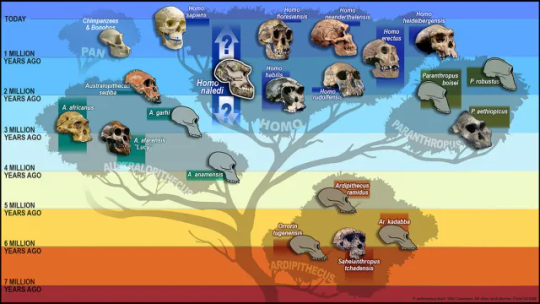
Homo sapiens is #9. Who were the eight other human species?
There were at least eight other human species, some of whom existed for far longer than we have. Who were they?
Around 6 million years ago, a branch of apes evolved to become the first species of the genus Homo. These early humans ditched the long arms of apes for stronger legs. While they could no longer swing around on trees, they could stand upright, walk, and colonize new ecosystems, away from the forest. The brains of early humans grew until we were using complex tools to hunt large animals, build fires, and construct shelters...
Read more: https://bigthink.com/the-past/other-human-species/
#hominid#hominin#primate#evolution#prehistoric#paleontology#ape#mammal#animals#nature#science#fossils
69 notes
·
View notes
Text
youtube
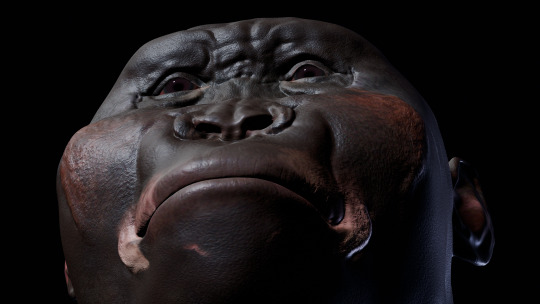

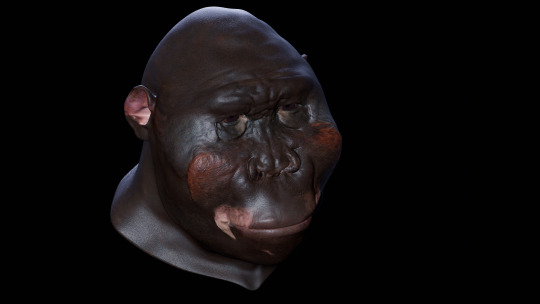
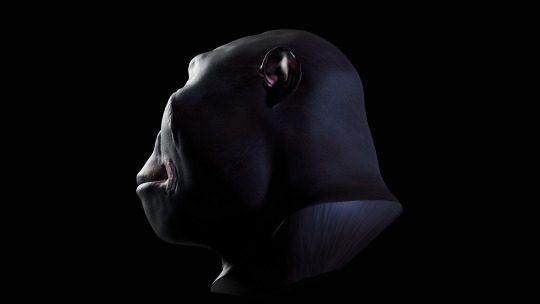
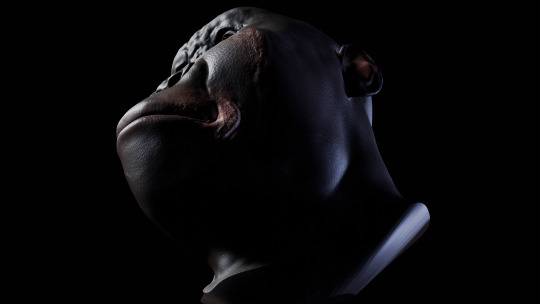



I've been working on 9 different Hominin reconstructions in Blender, and now I finally finished this Paranthropus boisei bust, reconstructed over a scan of fossil skull OH 5 provided by MorphoSource. The "skin" here is my significant modification of "free_basemesh_head_woman" created by Mono on SketchFab, because that had much better topology than I could make from scratch. These eight images are exported directly from Blender via a variety of camera setups, and the video fades between three additional versions of all these, including a Solid viewport shading option and a reveal of the underlying muscles, bone, and cartilage. Color and Displacement textures created in Photopea, 3d Object rendered in Blender, and video created with Clipchamp, 2024-25. More Hominins to come! Eventually!
#Blender#Digital Sculpture#3d Rendering#UV Texturing#Hominin#Human evolution#Paranthropus boisei#robust Australopiths#extinct primates#OH 5#Olduvai Hominin 5#MorphoSource#Blender Camera Export#video#Youtube#fossil reconstruction#craniofacial anatomy#paleoart#paleosculpture#bust#Pliocene#Tanzanian prehistory#Christopher Maida Artwork
30 notes
·
View notes
Text
Every once in a great while paleontological fieldwork turns up a fossil so extraordinary that it revolutionizes our understanding of the origin and evolution of an entire branch of the tree of life. Fifty years ago one of us (Johanson) made just such a discovery on an expedition to the Afar region of Ethiopia. On November 24, 1974, Johanson was out prospecting for fossils of human ancestors with his graduate student Tom Gray, eyes trained on the ground, when he spotted a piece of elbow with humanlike anatomy. Glancing upslope, he saw additional fragments of bone glinting in the noonday sun. In the weeks, months and years that followed, as the expedition team worked to recover and analyze all the ancient bones eroding out of that hillside, it became clear that Johanson had found a remarkable partial skeleton of a human ancestor who had lived some 3.2 million years ago. She was assigned to a new species, Australopithecus afarensis, and given the reference number A.L.288-1, which stands for “Afar locality 288,” the spot where she, the first hominin fossil, was found. But to most people, she is known simply by her nickname, Lucy. With the discovery of Lucy, scientists were forced to reconsider key details of the human story, from when and where humanity got its start to how the various extinct members of the human family were related to one another—and to us. Her combination of apelike and humanlike traits suggested her species occupied a key place in the family tree: ancestral to all later human species, including members of our genus, Homo.
9 notes
·
View notes
Text


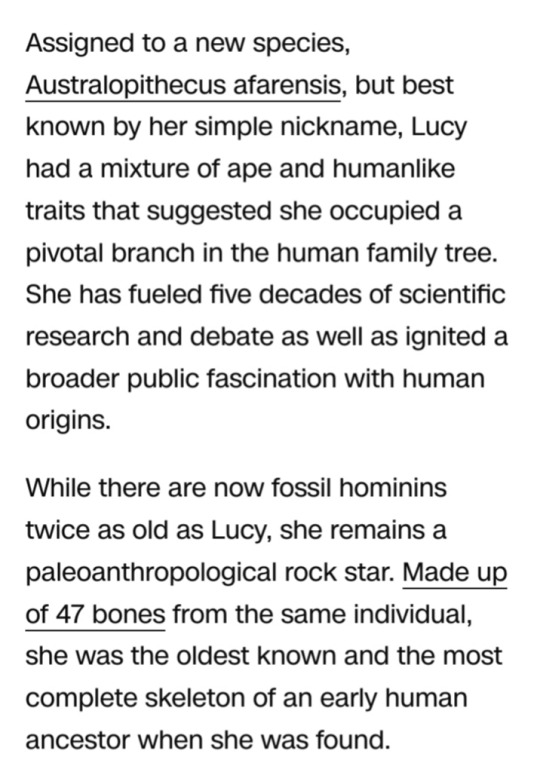





xxx
CNN: How did the fossil get the name Lucy?
Johanson: Because of the delicate nature of the bones and the short stature, we felt she was probably a female.
(Subsequent fossil discoveries revealed that males were much bigger than females.)
That night in camp, we were playing the Beatles’ (album).
“Sgt. Pepper’s Lonely Hearts Club Band” and “Lucy in the Sky With Diamonds” were playing when one of the camp members said, “Why don’t you call her Lucy?”
It was just serendipity that it happened, but it stuck. It was, in many ways, an attractive name.
People could identify with it. It made those bones a person. It drew you in and made you want to know more.
And she’s been the touchstone (of human origins) for the average person.
CNN: What was Lucy’s significance at the time that she was discovered?
Johanson: She was the oldest, most complete hominin known at that time.
This was terra incognita in the early ‘70s. Very few people had been to this region of Ethiopia, and people began launching their own expeditions and finding even more exciting things in some ways.
But I think that Lucy was the spark. She ignited a new stage in human origins research.
What she did, most importantly, was she broke the 3 million-year time barrier.
The site of Hadar, which is a local name, is very fossil-rich.
And it turned out to produce an enormous number of fossils of her species and gave us a really important benchmark by which all other discoveries that were made in the Afar could be judged.
#Lucy#Don Johanson#ethiopia#National Museum of Ethiopia#human evolution#paleontology#ancient hominins#Australopithecus afarensis#early human ancestor#Institute of Human Origins#Neanderthal genes#Neanderthals#homo sapiens#Denisovans#hominin species#argon dating#Hadar#fossils#fossilized skeleton#Tom Gray#human origins
3 notes
·
View notes
Text

An article published in the journal "Nature Communications" reports a study on new fossils belonging to the hominins called Homo floresiensis and nicknamed hobbits found at the site of Mata Menge, on the island of Flores. A team of researchers examined these new fossils dated to about 700,000 years ago and concluded that the species Homo floresiensis could descend from Asian Homo erectus.
3 notes
·
View notes
Text

This is "Little foot." A nearly complete fossil specimen of an Australopithecine. It is easily my favorite fossil specimen.
6 notes
·
View notes
Link
0 notes
Text

Here the result from the Pleistocene Flores #paleostream! This land, stuck between Sundaland and Australia revealed a fascinating fossil assemblage over the last few decades.

Dwarfed Stegodon, giant rats. huge marabou storks and komodo dragons are the most prominent members of the late Pleistocene fauna. Of these only the giant rats are still to be found on Flores.


Flores wasn't much of a household name in paleontology until 2004 - I remember it well - when a astonishing discovery was announced from the cave Liang Bua. Among the many animal remains were stone tools and surprisingly small hominin remains. After a lot of debate this would eventually be known as Homo floresiensis, a human species standing not much taller than 1 m. Little is known about this species. Especially it's cultural expressions and technological advances are the topic of many discussions and speculation.

One aspect that is rarely brought up in discussions around Flores are the birds, yes storks and vultures are popular but there is a huge number of living and fossil species found in these sites. As you can see in this size chart by Discord member JW there are still many interesting compositions to put together here. One thing that was important to me with this image was: 1. not to make it a dense jungle piece, and 2. not that make it a Stegodon hunting scene; that has been done too many times. The cave deposits at Liang Bua suggest that...


H. floresiensis inhabited this site especially during dryer intervals that would probably correlate with more open environments like the Lesser Sundas deciduous forests and savannas.
396 notes
·
View notes
Photo

Homo Habilis
Homo habilis ("handy man") is an extinct species of human that lived in East and South Africa between 2.3 and 1.5 million years ago and plays an interesting role in the discussion surrounding the dawn of our genus of Homo, which is thought to have first appeared around 2.5 million years ago.
Homo habilis was often seen as one of the earliest members of our genus and, for a long time, was commonly depicted as the ancestor of Homo erectus (thus, being a direct ancestor of our own species, too). Nowadays, this is debated, and a much more complex picture of the early days of Homo has emerged. Much discussion remains about the place of Homo habilis within this picture.
The fragmentary fossil record when it comes to Homo habilis (and many other species around at this early time) does not help; though we have a collection of skulls and skull fragments, only three so-called postcranial (below the skull) skeletons have been unearthed, and they are incomplete. The remains showcase a mishmash of features that in some parts resemble Homo, and in others resemble those found in Australopithecus.
What we do know is that Homo habilis was both fully bipedal, as well as a good and probably frequent climber, with strong hands that fashioned stone tools belonging to the Oldowan industry.
Discovery
Homo habilis was first described in 1964 by the British-Kenyan palaeoanthropologist Louis Leakey and his colleagues in a paper that rocked the scientific community. Along with his wife, Mary, Leakey had been combing Olduvai Gorge in Tanzania since the early 1950s in search of traces of Homo's first steps and had already discovered early stone tools belonging to what he termed the Oldowan industry. In the early 1960s, their son Jonathan found several skull and lower jaw fragments, along with some hand bones, in the same fossil bed that had yielded the tools. Soon, more remains were uncovered, including an adult foot, a skull with both upper and lower jaw, and a very fragmented skull with teeth.
Their verdict was that the new remains were quite 'modern' in appearance: they appeared closer to the genus Homo than to that of other early hominins like the Australopithecines. Clearly, this was a good fit for their toolmaker, they argued. Following the definition of Homo that was generally accepted at that time, the team felt the new fossils successfully met three of the key criteria: this species had an upright posture, could walk in a bipedal manner, and had the necessary dexterity to create stone tools. However, the fact that its brain volume was smaller than that of established members of Homo at the time required some fidgeting: the team thus proposed relaxing this criterion a bit.
Leakey's 1964 paper argued for the new species to be added to the genus Homo in the shape of Homo habilis – from the Latin for "handy, skilful, able". The announcement marked a turning point in palaeoanthropology, as Bernard Wood describes: "It shifted the search for the first humans from Asia to Africa and began a controversy that endures to this day." (2014).
Although the Homo habilis taxon was officially validated by the scientific community, it has frequently been challenged and criticised – a battle that is ongoing.
Continue reading...
38 notes
·
View notes
Text
A team of paleontologists at the Chinese Academy of Sciences, working with colleagues from Xi'an Jiaotong University, the University of York, the University of Chinese Academy of Sciences and the National Research Center on Human Evolution, has found evidence of a previously unknown human lineage. In their study, reported in Journal of Human Evolution, the group analyzed the fossilized jawbone, partial skull and some leg bones of a hominin dated to 300,000 years ago. The fossils were excavated at a site in Hualongdong, in what is now a part of East China. They were subsequently subjected to both a morphological and a geometric assessment, with the initial focus on the jawbone, which exhibited unique features—a triangular lower edge and a unique bend. The research team suggests that the unique features of the jawbone resemble those of both modern humans and Late Pleistocene hominids. But they also found that it did not have a chin, which suggests that it was more closely related to older species. They found other features that resemble hominins of the Middle Pleistocene, which, when taken together, suggested the individual most resembled a Homo erectus species. And that, they conclude, suggests a hybrid of modern human and ancient hominid.
Continue Reading
255 notes
·
View notes
Text
NOT COUNTING ROCKS (unless it’s a specific fossil from a time period you can name) or buildings (you cannot hold those)…
#Making my own because of the skew of the last one lol#My answer is still either acheulean hand-axes (800k years old) or Devonian/Silurian brachiopod fossils (350-450 million years old)#Depending on what u count#history#polls
97 notes
·
View notes
Text
Humans are dumb and predictable, we use it to learn.
So honestly one of my favorite parts about being an Anthropology Student and looking specifically into Paeleoanthropology is that we know the common human behaviors that have been done even though it like, damages our teeth and bones but we do it anyways and use that to determine things about us and others. One of these things is that Humans, even though it is damaging to our teeth tend to use our chompers as a Third Hand, like we hold onto so much stuff with it when we want to hold it steady or just dont have the room in our hands for it. We have been doing this hundreds of thousands of years and Paleoanthropologists in Spain have used that to determine if Homo Heidelbergensis, our Most Recent Hominin Ancestor(Basically the transition between Erectus and Sapiens) was mainly right handed or left handed. What they did was look at the damage marks fossilized teeth had, and saw the patterns, different damage patterns emerging if your holding say a bone in your teeth as you scrape the meat off of it with your stone tool. Weather your scraping with your left or right hand makes a distinctive pattern, and through that you can determine which hand they favored. As it turns out Heidelbergensis was largely Right handed! or at least the population that is in Sima De Los Huesos in Spain.
#science#anthropology#archeolo#paleoanthropology#fun facts#humans are weird#humans are dumb#College#i'm procrastinating
182 notes
·
View notes
Text

Dentist Discovers Human-Like Jawbone and Teeth in a Floor Tile
While touring his parents' recently renovated European home, a dentist spotted something unsettling. Embedded in a travertine floor tile along the hallway leading to the terrace was what appeared to be a human jawbone. Sliced diagonally, the tile revealed a cross-section of several teeth. Uncertain of the proper course of action, the dentist turned to Reddit, where the discovery ignited a frenzy of online interest, ranging from enthusiastic curiosity to sheer disgust.
The discovery has captured the attention of an international team of scientists who are eager to examine the fossil. They believe it could belong to an extinct human ancestor.
"If it turns out to be a fossil hominin, which I think it is, it should be studied and placed in a museum," John Kappelman, an anthropology professor at the University of Texas at Austin who specializes in hominid and hominin origins and evolution, said in an email.
Travertine, a type of limestone commonly used in construction due to its aesthetic appeal and longevity, often forms near mineral springs and can contain fossilized remnants of past life. While plant, algae, and even animal fossils like those of rhinos and giraffes are occasionally found in travertine, human remains are exceptionally rare, as noted by University of Wisconsin paleoanthropologist John Hawks, Forbes reported.
In a blog post titled "How Many Bathrooms Have Neanderthals in the Tile?" Dr. Hawks highlights the uncommon nature of this particular discovery.
"I expect there will be many twists and turns in the story of this jawbone," Mr Hawks wrote. "With some teeth preserved and abundant surrounding rock, I expect that specialists will be able to learn a great deal about the life of this individual and when he or she lived."

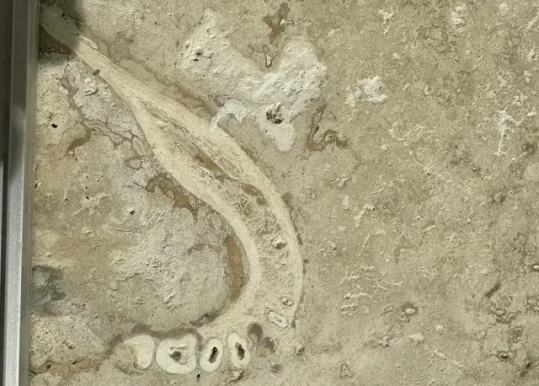
The European dentist, who specialises in dental implants, told Forbes that he immediately knew he wasn't just looking at stone tile's natural pattern variations when he saw several teeth staring up at him.
"From my dentist's point of view I had no doubt it was some kind of human," he told Forbes. "The teeth distribution and size of the mandible is characteristic. Also, the width of the cortex is specific to ancient humans."
"I don't think it is Jimmy Hoffa," the dentist joked in a follow-up to his original Reddit post. He said he prefers not to reveal his name, or his parents' location, to protect the family's privacy.
When the dentist spotted a jawbone as part of his parents' home upgrade, he was surprised for a different reason.
It is very, very unusual to find vertebrate fossils in processed travertine tile, and hominin fossils 100 times more so," Kappelman said. "We have only a handful."
Mr Kappelman was part of a team that observed the earliest evidence of tuberculosis etched on 500,000-year-old human skeletal remains discovered by factory workers in Turkey cutting travertine tile for commercial use. The scientists published the findings of their research in 2007 in The American Journal of Physical Anthropology.
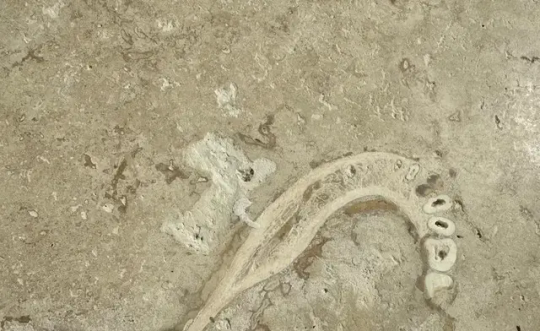
#Dentist Discovers Human-Like Jawbone and Teeth in a Floor Tile#travertine floor#human jawbone#fossils#archaeology#ancient artifacts#archeology#archeolgst#history#history news#strange#strange things#strange news
37 notes
·
View notes
Text
Humanity came close to extinction 800,000 years ago. Only 1,280 of our ancestors survived.
A recent study published in Science suggests that a catastrophic "ancestral bottleneck" reduced the global population to just 1,280 breeding individuals, wiping out 98.7% of the early human lineage.
This population crash, lasting about 117,000 years, likely resulted from extreme climate shifts, prolonged droughts, and dwindling food sources.
Using a groundbreaking genetic analysis method called FitCoal, researchers analyzed modern human genomes to trace this dramatic decline, potentially explaining a gap in the African and Eurasian fossil record.
Despite the near-extinction, this bottleneck may have played a crucial role in shaping modern humans. Scientists believe it contributed to a key evolutionary event—chromosome fusion—which may have set Homo sapiens apart from earlier hominin species, including Neanderthals and Denisovans. The study raises intriguing questions about how this small population survived, possibly through early fire use and adaptive intelligence. Understanding this ancient crisis helps scientists piece together the story of human evolution and the resilience that allowed our species to thrive against all odds.
learn more https://www.eurekalert.org/news-releases/999720

17 notes
·
View notes